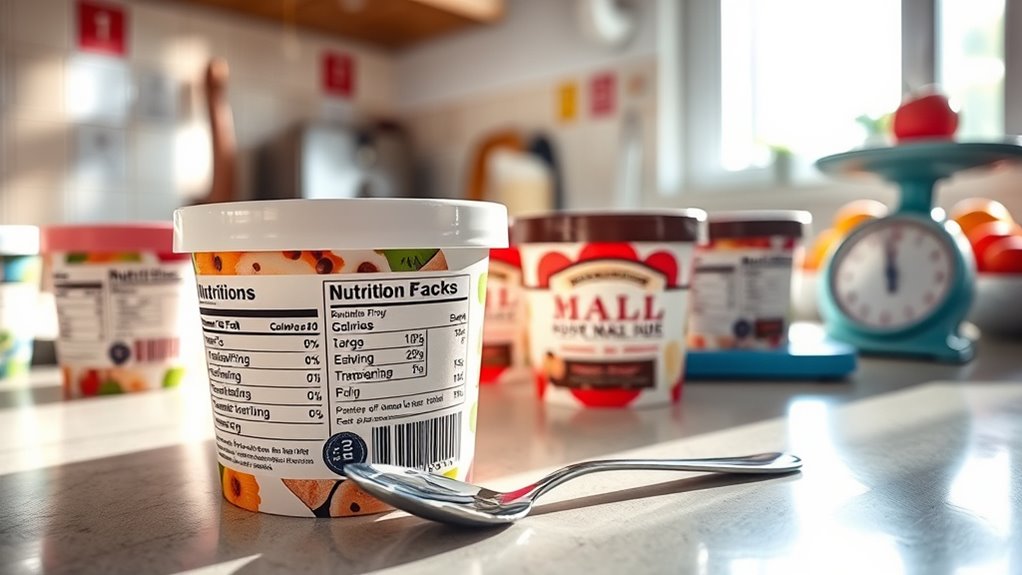When you’re choosing ice cream for your diet, start by checking the nutritional labels. Look for options with under 200 calories per serving and less than 20 grams of added sugar. Focus on ice creams made with recognizable ingredients and minimal additives. If you’re dairy-free, compare protein content and sugar levels. Also, manage your portion sizes by opting for pre-portioned servings or smaller bowls. There’s plenty more to discover about finding the perfect treat!
Key Takeaways
- Check the serving size and aim for options with under 200 calories per serving for better dietary balance.
- Look for ice creams with less than 20 grams of added sugar per 100 grams to manage sugar intake.
- Choose products with minimal, recognizable ingredients and avoid artificial additives for healthier options.
- Compare protein and saturated fat content, opting for dairy options with higher protein and lower saturated fat, or suitable dairy-free alternatives.
- Practice portion control by selecting mini sizes or pre-portioned servings to enjoy indulgence without overconsumption.
Understanding Nutritional Labels

When you’re choosing ice cream, understanding nutritional labels is essential to making healthier choices. Start by checking the serving size to accurately gauge calories per serving, keeping your daily intake in check.
Aim for options with less than 200 calories and under 20 grams of added sugar per serving, as recommended by the American Heart Association. Pay attention to saturated fat; ideally, go for ice creams with 4 grams or less per 100 grams to support heart health.
Look for recognizable ingredients that feature whole foods, steering clear of artificial additives. Finally, compare fiber content and protein per serving, seeking choices that offer at least 3 grams of fiber and 5 grams of protein to enhance the overall nutritional value.
Evaluating Ice Cream Ingredients

Evaluating ice cream ingredients is essential for making healthier choices that align with your dietary goals.
Focus on products that offer:
- Minimal, recognizable ingredients like cream, milk, and cocoa
- Low added sugars (aim for 20 grams or less per 100 grams)
- Reduced saturated fat (4 grams or less per 100 grams)
- Absence of artificial additives and long ingredient lists
- Quality ingredients without stabilizers or gums that might cause digestive issues
Choosing Between Dairy and Dairy-Free Options

How do you decide between dairy and dairy-free ice cream options? Start by considering your dietary needs. Dairy ice creams often have a higher protein content, but they can also be higher in saturated fat. On the other hand, dairy-free options cater to lactose intolerance but may sneak in added sugar and unhealthy fats. Always check the nutritional labels for ingredients and sugar levels; aim for under 20g of added sugar per 100g. Here’s a quick comparison:
| Ice Cream Type | Protein Content (per 100g) | Saturated Fat (per serving) |
|---|---|---|
| Dairy | 1g-5g | Often higher |
| Dairy-Free | Varies | Often lower |
| Healthier | Minimal ingredients | Lower fat options available |
Managing Portion Sizes

Managing portion sizes is essential for enjoying ice cream without overindulging. To help you savor your favorite treat while maintaining a healthy diet, consider these tips:
- Choose mini sizes or single-serving options, usually about 100 calories each.
- Use smaller bowls or cups to naturally control portion sizes.
- Opt for pre-portioned products that provide clear serving sizes, often around 1-2 scoops.
- Limit your servings to about 1/2 cup, which typically contains 140-210 calories.
- Practice mindful eating by fully enjoying each bite.
In addition, be mindful of the high sugar and fat content in traditional ice cream, which can contribute to health issues if consumed excessively.
Balancing Indulgence With Health

While enjoying ice cream can feel like a guilty pleasure, it doesn’t have to derail your health goals. You can indulge in a scoop without sacrificing your diet by choosing ice cream with under 200 calories per serving.
Look for products that contain less than 20 grams of sugar per 100 grams to keep excessive sugar intake at bay. Opt for ice creams with minimal ingredients, avoiding artificial additives for a healthier treat.
Choose ice creams with under 20 grams of sugar per 100 grams and minimal ingredients for a healthier indulgence.
Practicing portion control is key; consider pre-portioned cups or smaller servings to satisfy cravings without overindulging. Additionally, explore low-sugar or dairy-free options that align with your dietary preferences while still allowing for indulgence.
Enjoy your favorite treat guilt-free and maintain a balanced approach to your health!
Frequently Asked Questions
What Is the Best Ice Cream to Eat on a Diet?
When you’re looking for the best ice cream to eat on a diet, focus on varieties that keep calories under 200 per serving.
You’ll want to choose options with less than 20 grams of sugar per 100 grams to help manage your sugar intake. Low-fat or high-protein choices can be satisfying too.
Always check the ingredients for anything artificial, and consider portion control with single-serving cups to avoid overindulgence.
Enjoy your treat wisely!
What Is the Healthiest Ice Cream to Order?
When you’re looking for the healthiest ice cream to order, focus on options with minimal ingredients, like those made from cream and natural sweeteners.
Aim for choices with under 200 calories and less than 20 grams of sugar per serving.
Gelato can be a great pick due to its lower fat content, or try Greek yogurt-based ice creams for added protein.
Brands like Yasso or Goodpop also offer tasty, healthier alternatives that won’t disappoint!
How Do I Choose Healthy Ice Cream?
When it comes to choosing healthy ice cream, remember, “You can’t have your cake and eat it too.”
Look for options with less than 20 grams of added sugar per 100 grams and simple, recognizable ingredients.
Aim for ice creams with under 4 grams of saturated fat and around 600 kJ per 100 grams.
Finally, consider portion control by choosing single-serving containers to keep your indulgence in check without overdoing it.
Is It Okay to Eat Ice Cream When You Re Trying to Lose Weight?
Yes, it’s okay to eat ice cream while you’re trying to lose weight! Moderation is key. You can enjoy small portions to satisfy your cravings without derailing your progress.
Look for lower-calorie options and keep an eye on sugar content to make better choices. By practicing mindful eating and savoring each bite, you can indulge without guilt.
Conclusion
In the world of ice cream, it’s all about balance—after all, “everything in moderation” holds true! By understanding nutritional labels, evaluating ingredients, and choosing the right options for your diet, you can indulge without guilt. Remember to manage your portion sizes, and don’t forget that a little treat now and then can keep you motivated. So go ahead, scoop up your favorite flavor, and enjoy every delicious bite while staying on track with your health goals!










